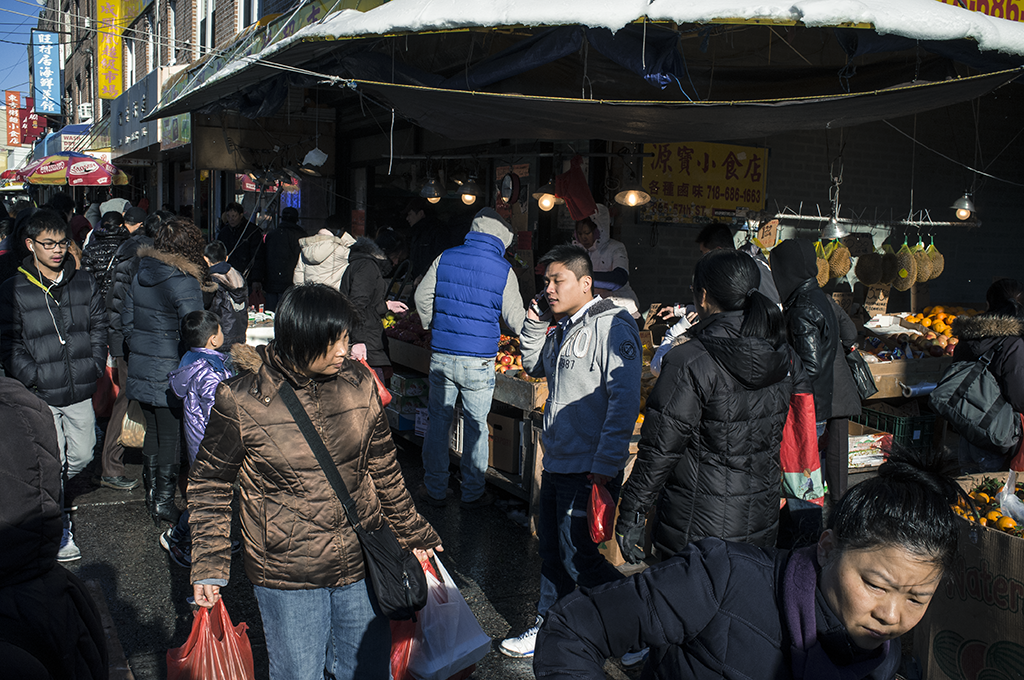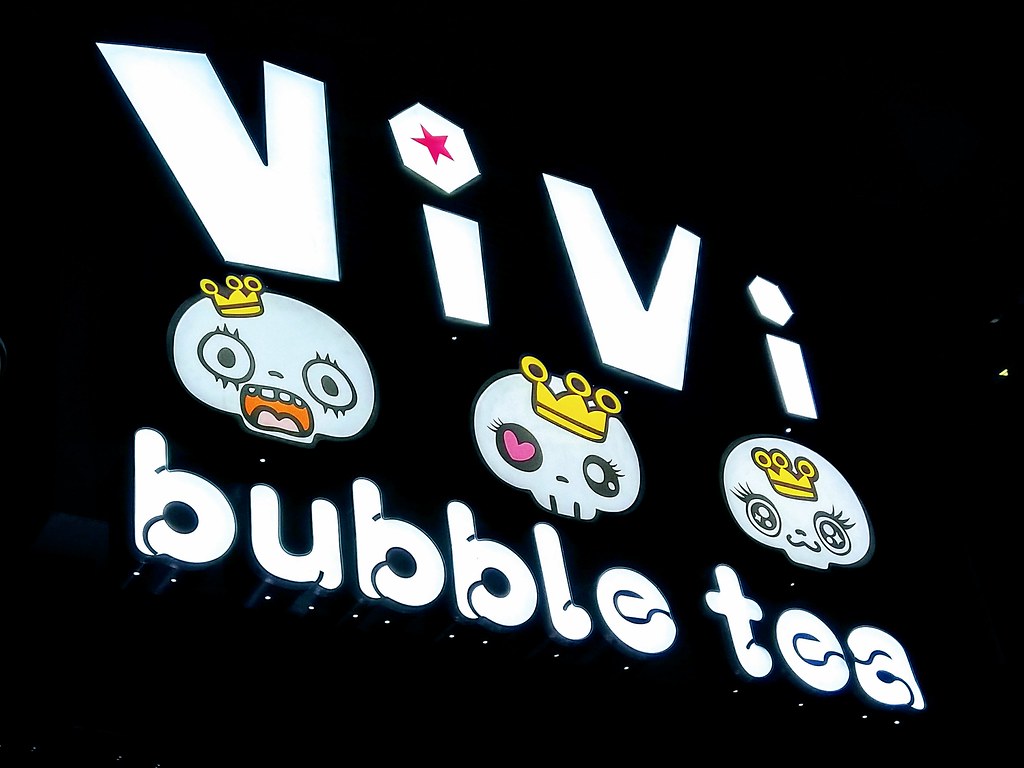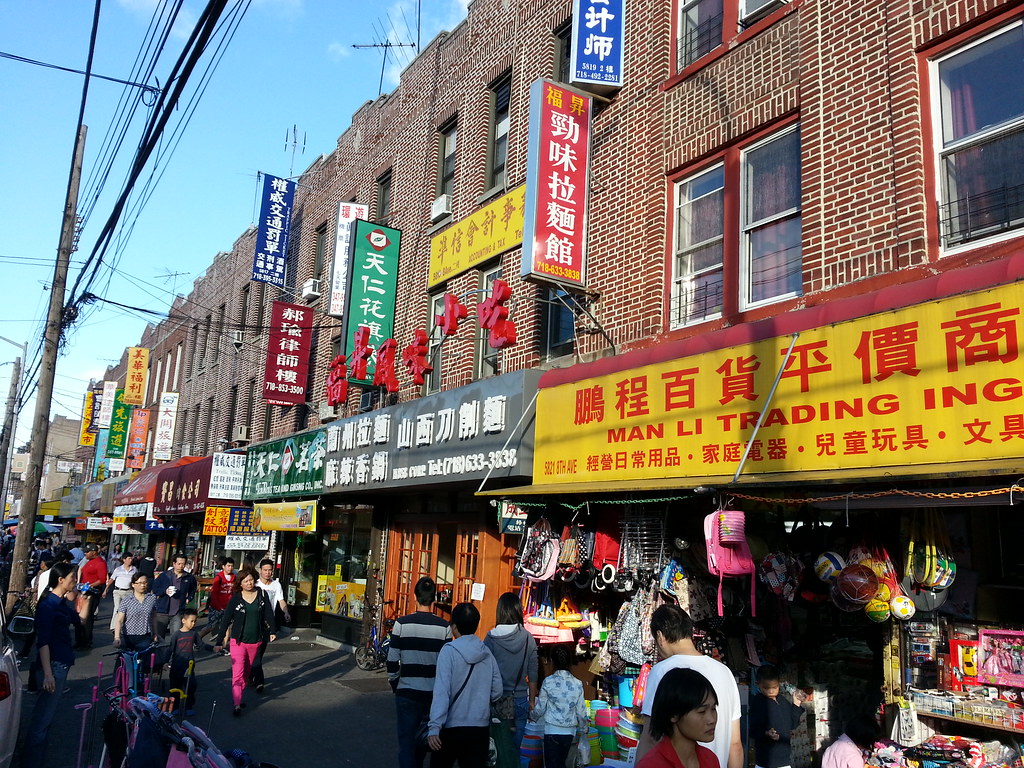
Featured image: 8th Avenue, Sunset Park. The Heart of Brooklyn’s Chinatown (Photo: Eric R. Bechtold).
By Candy Yang
“What should I say? I don’t know what to say.”
When I approached the lady working at China King, she seemed scared by what I asked. She did not answer my question but turned her head away and asked the man working in the back of the kitchen.
“Would you like to participate in my interview? It’s just a short, casual interview,” I repeated my request in Chinese. She ignored me and went back to the cashier, taking orders from customers.
I stopped talking and waited stubbornly for another five minutes for her to finish work. “So what do you want to know?” she asked suspiciously. I explained that I am a writer for the Yale Globalist and am currently writing about immigration and borders. Eventually, she agreed to have a conversation with me—but denied my request to record her.
Mrs. Zheng, who is from Fujian, China, immigrated to the United States in 1996. For her first four years in the U.S., she lived in New York and worked in a garment factory. Then, she worked in a kitchen for three years. After seeing her potential and effort, the boss decided to promote her to a “pass girl.” This role mainly entailed collecting plates and cleaning tables, but it also gave Mrs. Zheng a chance to leave the kitchen.
“That’s how I started talking with them, these foreigners. Sometimes they will ask me for simple requests like can you clean this area, or can you take away these plates. In the kitchen, you don’t get to talk to people,” she said.
Her use of the word “foreigner” is an interesting insight into the borders of the relationship between immigrants and citizens. Zheng sees American citizens as foreigners, who are unaware of her culture. These customers equally see Zheng as a foreigner, a Chinese immigrant who doesn’t know how to speak their language. There is a border between them, built from their backgrounds, languages, experiences, but mainly their unwillingness to communicate.
“I gradually started understanding what they were asking me to do, so I became a waitress. I started taking orders. I also learned how to take calls. Were you asking me how did I open China King? Well, it’s a step-by-step,” she said.
During our conversation, she frequently emphasized the term “step-by-step.” She believes that as long as people work hard and have the courage to face difficulties, they will overcome challenges step-by-step.
She went back to silence, saying that she had shared enough, so I stopped the interview despite my lingering questions: What brings you to America? What’s your dream? I was afraid that I would hurt her feelings and intrude on her personal boundaries if I continued asking questions. I had no idea what she had been through during her years as a worker at the garment factory and a restaurant owner, and to what extent she wanted to share that with me. It felt like the border she felt with other American citizens was present between us, despite our similar background and shared language.
Mrs. Zheng’s motive can be looked at with the “American Dream” in mind, a concept that Mary Lui, Professor of American Studies and History at Yale, explains as a relatively mainstream idea that is derived from the image of America: a land of freedom and mobility. The root of this idea has a long history and has been reshaped by many different generations.. Professor Lui said: “I think there are many dreams, where it goes from either own personal advancement in terms of finding work, personal safety, all the way to wanting better opportunities for their children, family. But many are typically about socio-economic security and mobility. And certainly there are people who are interested in religious freedom, political freedom as well.” “American Dream” is a universal phrase used in the immigrant’s group, but it has a complicated meaning, as no one shares a singular American dream. Nevertheless, all of the immigrants are pursuing this ideal step-by-step.
Mr. Lu, the business operator of ViVi, also opened his milk tea shop step-by-step, something that was evident in his busy schedule—I took several trips to ViVi to actually interview him. Lu, who is also from Fujian, China, immigrated to the U.S. with his parents in 1997. He was seventeen years old, but he started in the ninth grade of high school in New Haven. He left high school after three and a half years: “I don’t even know if I graduated or not, but I finished high school.” After high school, he had a variety of jobs, ranging from working as a cashier in the Hong Kong market in New Haven to running a radio store, and eventually opened his own restaurant. It was a four-thousand-square-foot buffet restaurant in Texas. He invested about two hundred thousand dollars in the renovation of the restaurant, but due to the lack of restaurant management experience and other factors, it went out of business after six months. After the failed business, he brought his family back to New Haven and went back to work at the Hong Kong market for five years.

Nevertheless, the failure of his buffet restaurant did not stop his drive to operate his own business. In 2009, he opened another restaurant in Chinatown of Brooklyn, New York, which mainly focused on serving Chinese immigrants with Chinese fast food. As Lu told me, “It’s for the Chinese in Chinatown.”
“I was among the first ones who opened fast-food restaurants, which was a new type of food in Chinese culture, so the business went pretty well. In 2011, I opened a grocery store nearby, about 2000 feet. The rent rate was high at that time, so a lot of people did not dare to open a new store, but I did it.” From his own perspective, Lu broke through the border. He dared to accept failure and continued to try to run his own business.
Professor Lui expressed her opinion about immigrant workers’ situation. A lot of their motives depend on the kinds of economic opportunities immigrants are finding here, the educational opportunities they did not have back in where they came from, and what they are able to bring and translate to life in the United States. Sometimes those skills are very easily translatable, an example being people who are high tech, high-skilled workers in another part of the world, as they are often able to just bring their skills and begin work, as they operate within the global economy. But for people who are not coming with those same amount of educational skills, it can be much tougher, and they often end up in certain sectors in the economy like the service sector, where it is very difficult to achieve all their goals due to the level of wages and the lack of job benefits like health care.
Lu’s journey circled back to New Haven, as he joined the ViVi company in 2015 and opened a branch in New Haven to sell milk tea to Yale students and the surrounding community.
When I asked if he had gone back to China, Lu told me that he visits back every year even though he does not have any family there. Most people in his village have immigrated to other countries: “When I went back, I could hardly see any young people in the village. It’s all old people, people who are retired, or young children, very, very young, three or four years old because their parents are working in the United States and they can’t raise their children.” With this, he further emphasizes that he is satisfied with his life now. He has a car, a house, and a family here. If he stays in China, he would not get what he wants.
Mr. Dong was the third person whom I interviewed. I met him in the Hong Kong Market, where I was trying to interview the owner. Unfortunately, he refused, but Mr. Dong, who was waiting behind me to check out, approached me afterwards and offered to help. Dong’s story was that of a college student, as he had finished his Ph.D. in China and studied abroad in Germany for one year with the aid of a government-sponsored scholarship. In the beginning, Dong wanted to become a professor in China, so he decided to come to America for further education, but ended up staying after he finished. Starting in January 2002, he began work at a pharmaceutical company. After a merger six years ago, he moved to New Haven to work for the new company.
Dong faces a border of mixed identity, as his daughter was born in the United States. Although he pointed out this border between him and his daughter, he seemed to accept its existence: “My daughter has a two-sided identity because she has told me that she thinks she is both Chinese and American. She is an American citizen. She thinks in English and in the way of American culture, but she admits that she has Chinese blood. It’s all about the difference between acknowledging and admitting. Acknowledge is a superficial consent while admit is to accept it from the bottom of your heart. Coming to America, I think I have learned to accept a lot of new things and different ideas. Some people have told me that I have a different point of view, but if I were the same as everyone else, then I would have never gone abroad.”
Professor Lui adds her opinion about the mixed identity that exists generationally among immigrants. She agrees but adds that there is always a generational gap no matter where you are, because the time is moving on. “Even if people don’t immigrate, there is still going to be that gap. That’s really important rather than just assume there must be the immigrant generation gap. We just have to make sure that we understand that time is always moving, and usually when people are talking about the gap, they are only seeing it from one vantage point. And they usually think of it as time is fixed, but time is never fixed. That said, sure, it’s to be expected that someone growing up in the United States, especially if they are coming at a young age, going to school in the United States, having opportunities in the U.S, is going to be really different. But there’s no definitive second-generation Chinese-American experience. It’s so varied across where they might be growing up. For example, the kids that grow up in the New York City are going to be very different from the people growing up from the suburban Illinois. Just because you are born in the U.S., doesn’t mean it’s exactly the same.”
Immigrant parents always feel the struggle or the sense of loss of trying to hold on, and seeing their children not being who they are. In this multicultural era, it is crucial that people know that culture is not something fixed, but is a product of time, backgrounds, experiences, education, religions, and so on. Communication with second generation immigrants can be difficult due to misunderstandings and unfamiliarity. Some Chinese immigrants may feel pressure to neglect their Chinese culture to integrate into American culture, but this implicit, diligent, and pragmatic culture exists in every Chinese immigrant’s blood. Resisting these borders in cross-cultural communication not only shows pride in their Chinese culture but also helps them understand American culture.
I asked Mr. Dong if Chinese immigrants should integrate themselves into American society or have their own social circle, like that of Chinatown. He replied: “One of the cultural downsides of working is that it’s hard for Chinese people to break into American social circles. There is a certain border. I work with some Americans, but I won’t go having a beer with them after work because they talk about topics that don’t interest me. And the biggest disadvantage of Chinese is that they like to talk about work after work. Foreigners never talk about work. Chinese people attach too much importance to work and study, while Americans enjoy themselves. It’s just that I don’t have to adapt to their culture. I have my life. I have myself. No one should judge me if I integrate into American society or not.”

Professor Lui adds: “I think I would actually challenge the idea of a border. Let’s take New York City for example, it’s not like there is an actual border that people are physically passing. It’s sometimes difficult for people to know: is it Chinatown or is it not Chinatown. I also think there’s a lot more movement that people seem to suggest. No doubt that Chinatown is a designated tourist location that people see on the map. There’s a lot of physical marker that suggests it’s Chinatown, but people are constantly going in and out. Even people who might live there could well be going to school or working or something somewhere else in the city. They are not necessarily spending 24/7 in these few blocks at all. People are going to many places, but that doesn’t mean that they don’t feel a real sense of deep attachment of belonging to Chinatown. I think if the whole point of people coming is to really pursue the lives they want to lead, then people should be allowed to lead the lives they want to lead, as long as they are being productive members of society. They are contributing in some way, and there are many ways that ethnic communities are incredibly vibrant, wonderful, and useful for generating economic development and cultural vibrancy.”
All three of the people I interviewed have different experiences with America, but have faced a certain kind of border in their attempts to address their new home and identity. Eventually, it goes back to the question that Professor Lui prompted. Is there really a border? Why is there a conversation about a border? The border is not the physical border showed on the map, but is the invisible border in every immigrant’s heart—the defensive and obsolete mind that makes one become afraid of unfamiliar things. However, Mr. Lu dared to take the challenges, accept the failure, and do it again, while Mr. Dong accepted and faced up the border between him and his daughter. It is hard to break the border inside of the heart but mentality is a key factor, just as Mrs. Zheng said. The choices made, the people met, and the obstacles faced and conquered are all valuable life experiences that have shaped Chinese immigrants in America into people who overcome challenges courageously and embrace the changes gratefully.
Candy Yang is a first-year in Jonathan Edwards College studying Computer Science and Economics. She can be contacted at candy.yang@yale.edu.